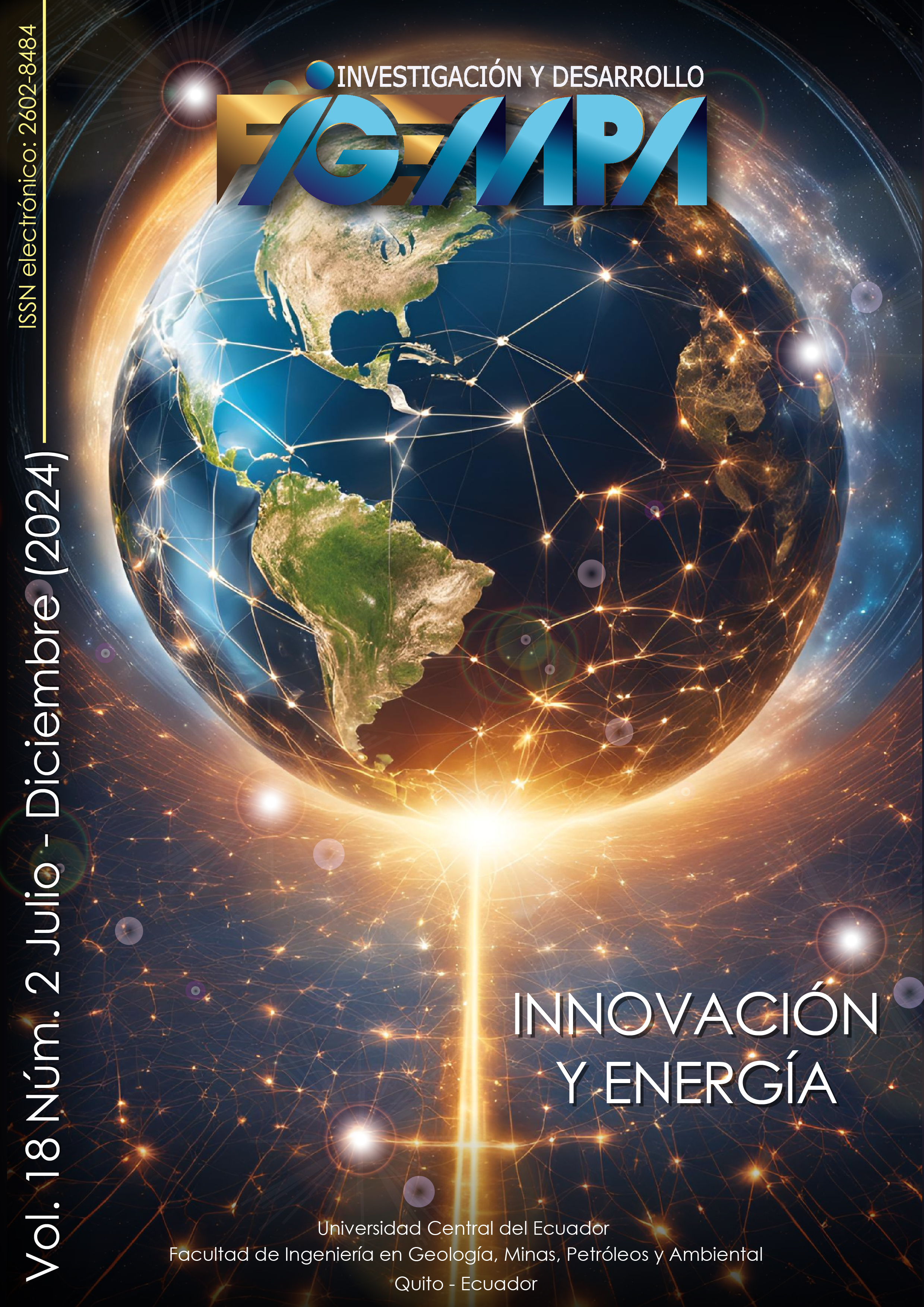CO2 corrosion trend of natural gas based on its composition using Artificial Neural Networks
Main Article Content
Abstract
Corrosion is a recurrent problem in the natural gas industry, due to the presence of corrosive gases such as CO2 and H2S that in the presence of water can attack steel and produce damages and leaks that generate accidents and contamination, that is why the prediction of the tendency of natural gas towards corrosion is essential to develop strategies to inhibit and mitigate this process. The objective of the study was to develop an Artificial Neural Network (ANN) trained with composition data of natural gas samples to predict the corrosive tendency, as an alternative method that can be used as an efficient predictive tool. The ANN was trained with a sample of 46 natural gases and 11 components for each one, in addition to pressure and temperature as operational conditions, representing a total of 598 training data of the ANN, also 8 additional samples were used for external validation of the model. The ANN that developed was within the principles of Bayesian statistics, with a Multilayer Perceptron architecture. It was obtained that the ANN is able to correctly classify 95.65% of the corrosive tendency of the samples, being those with non-corrosive tendency the ones that presented the lowest prediction percentage (75%). The prediction of the external samples followed the expected trend, with lower capacity to classify the non-corrosive ones, and the samples with possible corrosion and corrosive were predicted in 80%. It is concluded that ANN is an efficient tool for predicting the corrosive tendency of natural gas in the presence of CO2 and its effectiveness depends on using samples with all the necessary components to train it, and it can be improved by introducing other parameters such as the amount of water present.
Downloads
Metrics
Article Details

This work is licensed under a Creative Commons Attribution 4.0 International License.
References
Alarouj, M., Alomair, O. y Elsharkawy, A. (2020) “Gas condensate reservoirs: Characterization and calculation of dew-point pressure”, Petroleum Exploration and Development, 47 (5), pp. 1091-1102. DOI: 10.1016/S1876-3804(20)60120-3 DOI: https://doi.org/10.1016/S1876-3804(20)60120-3
Alqahtani, H., Sarker, I. H., Kalim, A., Minhaz Hossain, S. M., Ikhlaq, S. y Hossain, S. (2020) “Cyber intrusion detection using machine learning classification techniques”. Computing Science, Communication and Security: First International Conference, COMS2 2020. Singapur: Springer, pp. 121-131. DOI: 10.1007/978-981-15-6648-6_10 DOI: https://doi.org/10.1007/978-981-15-6648-6_10
Ayello, F., Robbins, W., Richter, S. y Nešić, S. (2013) “Model compound study of the mitigative effect of crude oil on pipeline corrosion”, Corrosion, 69 (3), pp. 286-296. DOI: 10.5006/0631 DOI: https://doi.org/10.5006/0631
Chin, K. T., Arumugam, T., Karuppanan, S. y Ovinis, M. (2020) “Failure pressure prediction of pipeline with single corrosion defect using artificial neural network”, Pipeline Sci. Technol, 4 (1), pp. 10-17. DOI: 10.28999/2514-541X-2020-4-1-10-17 DOI: https://doi.org/10.28999/2514-541X-2020-4-1-10-17
Faramawy, S., Zaki, T. y Sakr, A. A.-E. (2016) “Natural gas origin, composition, and processing: A review”, Journal of Natural Gas Science and Engineering, 34, pp. 34–54. DOI: 10.1016/j.jngse.2016.06.030 DOI: https://doi.org/10.1016/j.jngse.2016.06.030
Farhadian, A., Varfolomeev, M. A., Kudbanov, A., Rezaeisadat, M. y Nurgaliev, D. K. (2020) “Waterborne polymers as kinetic/anti-agglomerant methane hydrate and corrosion inhibitors: A new and promising strategy for flow assurance”, Journal of Natural Gas Science and Engineering, 77, p. 103235. DOI: 10.1016/j.jngse.2020.103235 DOI: https://doi.org/10.1016/j.jngse.2020.103235
Feng, R., Beck, J. R., Hall, D. M., Buyuksagis, A., Ziomek Moroz, M. y Lvov, S. N. (2018) “Effects of CO2 and H2S on corrosion of martensitic steels in brines at low temperature”, Corrosion, 74 (3), pp. 276-287. DOI: 10.5006/2406 DOI: https://doi.org/10.5006/2406
Groysman, A. (2017) “Corrosion problems and solutions in oil, gas, refining and petrochemical industry”, KOM–Corrosion and Material Protection Journal, 61 (3), pp. 100-117. DOI: 10.1515/kom-2017-0013 DOI: https://doi.org/10.1515/kom-2017-0013
Jiang, G., Keller, J., Bond, P. L. y Yuan, Z. (2016) “Predicting concrete corrosion of sewers using artificial neural network”, Water research, 92, pp. 52-60. DOI: 10.1016/j.watres.2016.01.029 DOI: https://doi.org/10.1016/j.watres.2016.01.029
Li, J., Wang, D. y Xie, F. (2022) “Failure analysis of CO2 corrosion of natural gas pipeline under flowing conditions”, Engineering Failure Analysis, 137, p. 106265. DOI: 10.1016/j.engfailanal.2022.106265 DOI: https://doi.org/10.1016/j.engfailanal.2022.106265
Marín Velásquez, T. D. y Arriojas Tocuyo, D. D. J. (2020) “Efecto de la mezcla de aceites de Anacardium occidentale/Cocos nucífera en gasoil sobre la velocidad de corrosión de acero al carbono en solución salina”, Revista Tecnología en Marcha, 33 (4), pp. 37-46. DOI: 10.18845/tm.v33i4.4484 DOI: https://doi.org/10.18845/tm.v33i4.4484
Marín, T. D. y Arriojas, D. D. J. (2021) “Ubicación de revistas científicas en cuartiles según SJR: Predicción a partir de estadística multivariante”, Anales de Documentación, 24 (1), pp. 1-11. DOI: 10.6018/analesdoc.455951. DOI: https://doi.org/10.6018/analesdoc.455951
NACE SP106 (2018) Control of Internal Corrosion in Steel Pipelines and Piping Systems. Houston: National Association of Corrosion Engineers International.
Nayak, N., Anarghya, A. y Al Adhoubi, M. (2020) “A study on the behavior of CO2 corrosion on pipeline using computational fluid dynamics, experimental and artificial neural network approach”, Engineering Research Express, 2 (2), p. 025012. DOI: 10.1088/2631-8695/ab69d6 DOI: https://doi.org/10.1088/2631-8695/ab69d6
Perez, T. E. (2013) “Corrosion in the oil and gas industry: an increasing challenge for materials”, Jom, 65 (8), pp. 1033-1042. DOI: 10.1007/s11837-013-0675-3 DOI: https://doi.org/10.1007/s11837-013-0675-3
Valdez, B., Schorr, M. y Bastidas, J. M. (2015) “The natural gas industry: equipment, materials, and corrosion”, Corrosion Reviews, 33 (3-4), pp. 175-185. DOI: 10.1515/corrrev-2015-0012 DOI: https://doi.org/10.1515/corrrev-2015-0012
Verma, C., Quraishi, M. A. y Rhee, K. Y. (2022) “Hydrophilicity and hydrophobicity consideration of organic surfactant compounds: Effect of alkyl chain length on corrosion protection”, Advances in Colloid and Interface Science, 306, p. 102723. DOI: 10.1016/j.cis.2022.102723 DOI: https://doi.org/10.1016/j.cis.2022.102723
Wang, Y., Li, Y., Song, Y. y Rong, X. (2020) “The influence of the activation function in a convolution neural network model of facial expression recognition”, Applied Sciences, 10 (5), p. 1897. DOI: 10.3390/app10051897 DOI: https://doi.org/10.3390/app10051897
Wang, Y., Wang, H. y Peng, Z. (2021) “Rice diseases detection and classification using attention based neural network and bayesian optimization”, Expert Systems with Applications, 178, p. 114770. DOI: 10.1016/j.eswa.2021.114770 DOI: https://doi.org/10.1016/j.eswa.2021.114770
Wu, S., Zhu, X. y Wang, H. (2023) Subsampling and jackknifing: a practically convenient solution for large data analysis with limited computational resources. Ithaca, New York: Cornell University. Disponible en https://arxiv.org/abs/2304.06231. DOI: 10.48550/arXiv.2304.06231 DOI: https://doi.org/10.5705/ss.202021.0257

